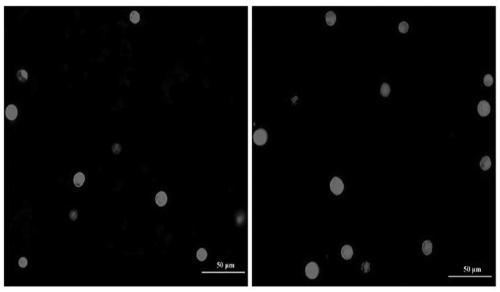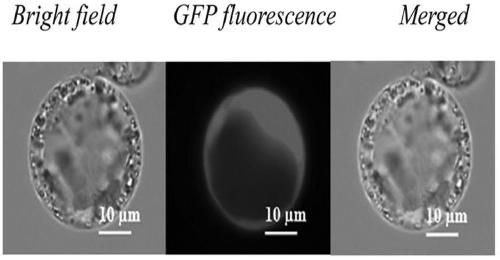Establishment method of high efficient transient transformation system of exogenous genes of cunninghamia lanceolata
A technology of exogenous gene and transient transformation, applied in the field of plant cytology, can solve the problems of immature separation and purification system, and achieve the effects of cost saving, broad application prospects and high-efficiency expression
- Summary
- Abstract
- Description
- Claims
- Application Information
AI Technical Summary
Problems solved by technology
Method used
Image
Examples
Embodiment 1
[0021] Choose healthy annual Chinese fir seedlings, cut the main stem into 9cm stem segments, and peel off the bark. Put the peeled stem segments prepared above into a 50mL tube containing 40mL of enzymatic hydrolysis solution, put 4 stem segments of 9cm in one tube, and incubate for 4 hours in the dark and avoid light at a temperature of 25°C to obtain the enzymatic hydrolysis solution. stem segments. Transfer the enzymatically treated stem section from the enzymolysis solution to the MMG solution, shake gently horizontally for 2 minutes to release the protoplasts, and the MMG solution becomes turbid to obtain a protoplast suspension; fold the protoplast suspension with a 70 μm filter for 2 Layer was filtered, the filtrate was collected, the filtrate was centrifuged at 300 g for 5 min, the supernatant was sucked off, and the precipitate remained, and the precipitate was resuspended with 1 mL MMG to obtain a protoplast suspension. Take 10 μL of isolated protoplasts and add th...
Embodiment 2
[0028] Choose healthy annual Chinese fir seedlings, cut the main stem into 10cm stem segments, and peel off the bark. Put the peeled stem sections prepared above into a 50mL tube containing 40mL of enzymatic hydrolysis solution, put 4 stem sections of 10cm in one tube, and incubate for 3 hours in the dark and away from light at a temperature of 25°C to obtain the enzymatic hydrolysis solution. stem segments. Transfer the enzymatically treated stem section from the enzymolysis solution to the MMG solution, shake gently horizontally for 2 minutes to release the protoplasts, and the MMG solution becomes turbid to obtain a protoplast suspension; fold the protoplast suspension with a 70 μm filter for 2 Layer was filtered, the filtrate was collected, the filtrate was centrifuged at 300 g for 5 min, the supernatant was sucked off, and the precipitate remained, and the precipitate was resuspended with 1 mL MMG to obtain a protoplast suspension. Take 10 μL of isolated protoplasts and ...
Embodiment 3
[0035] Choose healthy annual Chinese fir seedlings, cut the main stem into 8cm stem segments, and peel off the bark. Put the peeled stem segments prepared above into a 50 mL tube containing 40 mL of enzymatic hydrolysis solution, put 4 stem segments of 8 cm in one tube, and incubate for 2 hours in the dark and away from light at a temperature of 26°C to obtain enzymatic hydrolysis Liquid-treated stem segments. Transfer the enzymatically treated stem section from the enzymolysis solution to the MMG solution, shake gently horizontally for 1 min to release the protoplasts, and the MMG solution becomes turbid to obtain a protoplast suspension; fold the protoplast suspension with a 70 μm filter for 2 Layer was filtered, the filtrate was collected, the filtrate was centrifuged at 300g for 5min, the supernatant was sucked off, and the precipitate remained, and the precipitate was resuspended with 1 mL MMG to obtain a protoplast suspension. Take 10 μL of isolated protoplasts and add ...
PUM
 Login to View More
Login to View More Abstract
Description
Claims
Application Information
 Login to View More
Login to View More - R&D
- Intellectual Property
- Life Sciences
- Materials
- Tech Scout
- Unparalleled Data Quality
- Higher Quality Content
- 60% Fewer Hallucinations
Browse by: Latest US Patents, China's latest patents, Technical Efficacy Thesaurus, Application Domain, Technology Topic, Popular Technical Reports.
© 2025 PatSnap. All rights reserved.Legal|Privacy policy|Modern Slavery Act Transparency Statement|Sitemap|About US| Contact US: help@patsnap.com


